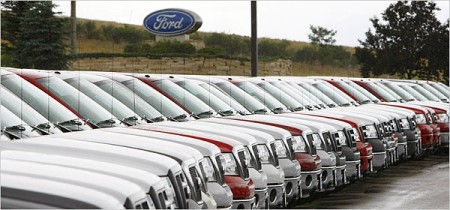
DETROIT – The Ford Motor Company, stunned by abysmal sales of its most profitable vehicles and a sudden shift in consumers’ tastes, said Thursday that it lost $8.7 billion in the quarter, its worst ever, and would overhaul its North American plants to focus on small cars.
The loss, equal to $3.88 a share, was mostly the result of $8 billion in write-downs because of falling demand for and resale values of gas-thirsty pickups and sport utility vehicles in the United States. Ford took charges of $5.3 billion charge related to lower asset values in North America and $2.1 billion on the lease portfolio at its financing arm, the Ford Motor Credit Company.
The news sent Ford shares tumbling nearly 10 percent in morning trading.
Excluding the write-downs and other charges, the company lost $1 billion from continuing operations, down from a profit of $483 million a year ago. It lost $1.3 billion in North America, where $4-a-gallon gasoline has caused consumers to clamor for more fuel-efficient vehicles.
Ford said it would cut production for the rest of the year by an additional 105,000 vehicles, for a total reduction of 26 percent compared with the second half of 2007.
Then, it plans to overhaul three truck factories in North America so they can build small cars and double production of gas-electric hybrid vehicles next year.
Among the cars that Ford will start building and selling in North America are six small cars from Europe, where years of high gasoline have educated automakers how to earn larger profits on those vehicles than they have historically generated in the United States.
“External conditions in North America have changed dramatically in a very short period of time,” said Mark Fields, the president of Ford’s Americas division. “While we have no intention of giving up our longtime truck leadership, we are creating a new Ford in North America on a foundation of small, fuel-efficient cars and crossovers.”
In the second quarter of 2007, Ford earned a profit of $750 million, or 31 cents a share. In April, the company surprised Wall Street with a $100 million first-quarter profit, but the market for its most profitable vehicles has deteriorated swiftly since then.
Revenue fell to $38.6 billion in the second quarter from $44.2 billion a year ago, in part because the company has sold three European brands – Jaguar, Land Rover and Aston Martin.
Ford’s automotive operations earned a profit in every region except North America, where the company eliminated 4,000 hourly jobs in the last three months and is working to cut 15 percent of salaried costs by Aug. 1. Revenue in North America dropped 25 percent to $14.2 billion, from $19 billion.
Ford Motor Credit, which until recently had been a consistent source of income, reported a $294 million loss excluding its write-downs, compared with a $112 million profit last year.
Ford executives said they expected the United States market to remain sluggish through next year and that the nation’s economy would not recover significantly until 2010. The company’s chief financial officer, Don R. Leclair, said Ford had $26.6 billion in cash on hand, down $10.8 billion from a year ago but enough to sustain its restructuring.
“We have absolutely the right plan to respond to the changing business environment and begin to grow again for the long term,” the chief executive, Alan R. Mulally, said.
Ford is relying on small cars to fuel that growth, rather than the high-profit big trucks and S.U.V.’s that propelled it through recent decades. It plans to retool a sport utility vehicle factory in Michigan and begin making compact cars there in 2010. An S.U.V. plant in Kentucky will start building small cars in 2011. The company has already announced plans to build a new subcompact car, the Fiesta, at a former truck factory in Mexico.
Meanwhile, a plant in St. Paul, Minn., that was scheduled to close next year will stay open through 2011 to continue building the Ford Ranger, a compact pickup for which demand has increased as drivers downsize from full-size pickups.
Ford also plans to double its capacity to build fuel-efficient, four-cylinder engines in North America by 2011.
At the same time, it will reduce costs by paring the number of different platforms on which its cars worldwide are based to 9 from 25 today.
Ford’s sales fell 14 percent in the first half of the year, compared with 10.1 percent for the industry overall. But in June alone, Ford’s sales were off 27.9 percent, including a 35.3 percent drop for its trucks.
The disappointing performance led executives to back away from the company’s previous goal of returning to profitability next year. Ford is now expected to lose money for a fourth consecutive year in 2009.
The automaker has already been slowing production of its larger vehicles, while running plants that make the Ford Focus compact car and other sedans on overtime. It is delaying the introduction of its redesigned full-size pickup truck, the 2009 F-series, for two months this fall while dealers grapple with an oversupply of the current model.
The F-series has been the best-selling vehicle in the United States for 26 years, but in May and June it suddenly fell to fifth, behind four Japanese sedans.
The deteriorating market for Ford’s most profitable vehicles caused shares of the company to lose nearly half their value in a two- month period. The stock fell to a 23-year low of $4.30 on July 3.
That drop occurred even as the billionaire investor Kirk Kerkorian increased his stake in Ford and expressed optimism about the automaker’s future under Mr. Mulally. As of mid-June, Mr. Kerkorian owned 140.8 million shares of Ford, which he bought for as much as $8.50 each.
July 25, 2008
By NICK BUNKLEY
Source: Telegraph